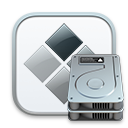This article needs to be updated.(June 2020) |
| Boot Camp Assistant | |
|---|---|
 | |
 Boot Camp running on macOS Monterey | |
| Developer | Apple Inc. |
| Initial release | October 26, 2007 |
| Stable release | |
| Type | Software assistant for dual booting |
| License | Proprietary |
| Website | support |
Boot Camp Assistant is a multi-boot utility included with Apple Inc.'s macOS, previously Mac OS X/OS X, that assists users in installing Microsoft Windows operating systems on Intel-based Macintosh computers. The utility guides users through non-destructive disk partitioning, including resizing of an existing HFS+ or APFS partition, if necessary, of their hard disk drive or solid-state drive and installation of Windows device drivers for the Apple hardware. The utility also installs a Windows Control Panel applet for selecting the default boot operating system.
Contents
- Overview
- Installation
- Start-up Disk
- Requirements
- Mac OS X 10.7 Lion and OS X 10.8 Mountain Lion
- Mac OS X 10.5 Leopard and Mac OS X 10.6 Snow Leopard
- Supported Mac computers with Windows 8
- Limitations
- Boot Camp version history
- Boot Camp support software (for Windows) version history
- See also
- References
- External links
Initially an unsupported beta for Mac OS X 10.4 Tiger, the utility was introduced with Mac OS X 10.5 Leopard and has been included in subsequent versions of the operating system. [1] [2] Previous versions of Boot Camp supported Windows XP and Windows Vista. Boot Camp 4.0 for Mac OS X 10.6 Snow Leopard version 10.6.6 up to Mac OS X 10.8 Mountain Lion version 10.8.2 supported only Windows 7. [3] With the release of Boot Camp 5.0 for Mac OS X 10.8 Mountain Lion in version 10.8.3, only 64-bit versions of Windows 7 and Windows 8 are supported. [4] [5]
Boot Camp 6.0 added support for 64-bit versions of Windows 10. Boot Camp 6.1, available on macOS 10.12 Sierra and later, will accept only new installations of Windows 7 and later. This requirement was upgraded to requiring Windows 10 for macOS 10.14 Mojave.
Boot Camp is not available on Apple silicon Macs. [6] Via virtualization, it is possible to run ARM-based Windows 10 or Windows 11. [7]
